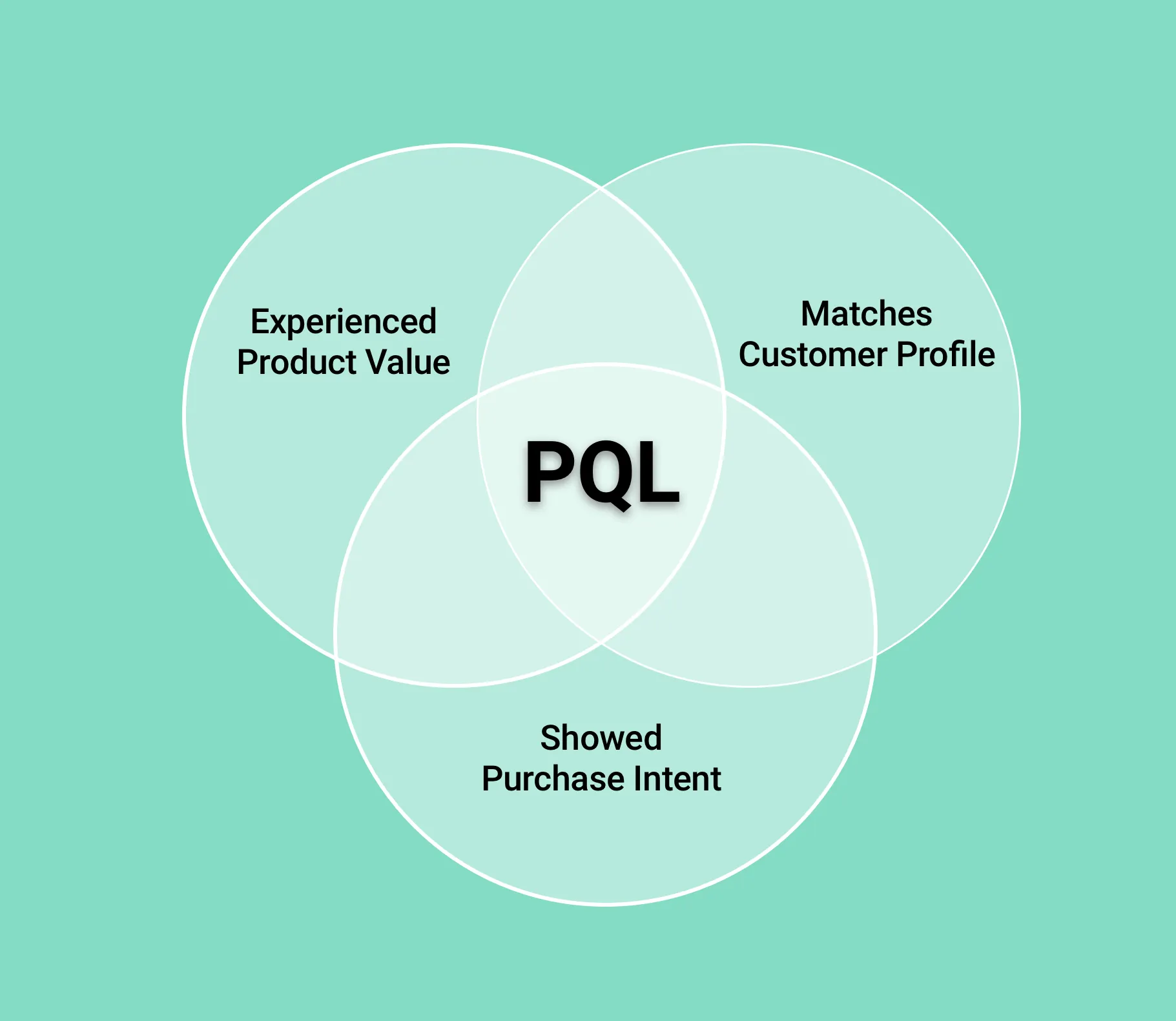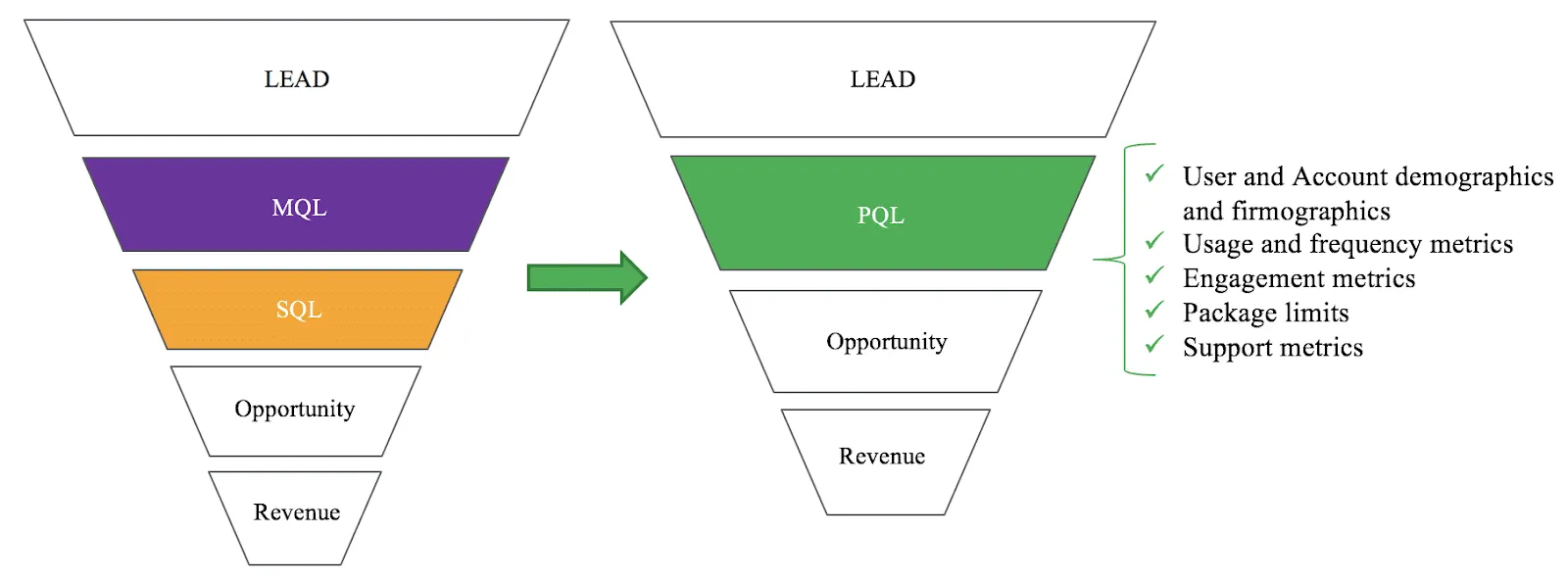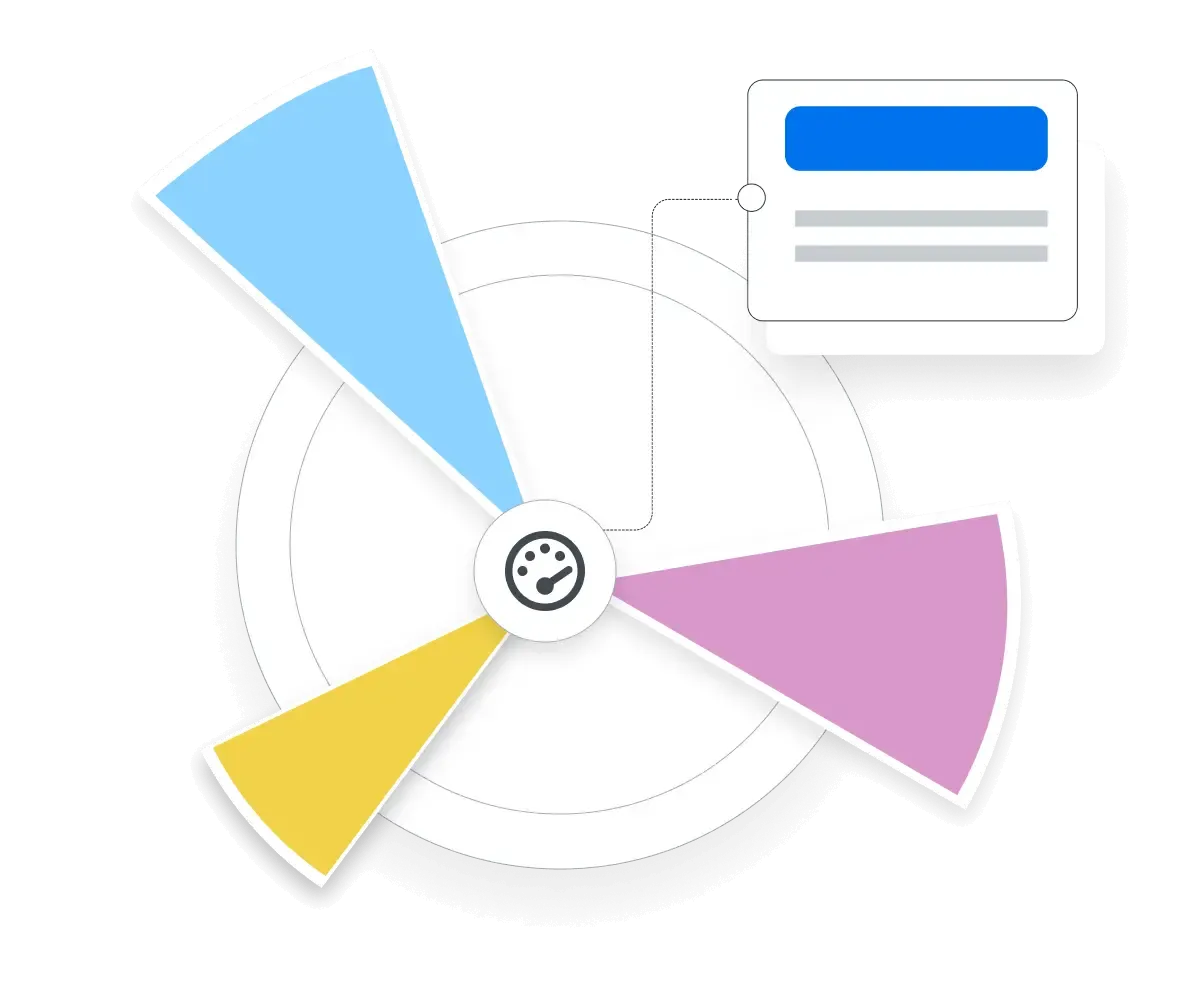Introduction to Product Qualified Leads

What are PQLs?
Product Qualified Leads (PQLs) are prospective or potential customers who have engaged with a product extensively, demonstrating a high level of interest that suggests they are likely to become paying customers. Unlike traditional leads, which might be identified through information gathering or first contact like marketing qualified leads (MQLs) or sales qualified leads (SQLs):
- Usage-based qualification: PQLs are identified based on their interactions with a product, such as feature usage or engagement metrics, demonstrating real interest and familiarity with the product.
- Intent demonstration: They may have reached usage thresholds that suggest buying intent, such as exceeding a usage limit on a free trial or interacting extensively with key features.

Why Not All Users Are PQLs?
Not every user who tries a product qualifies as a PQL. The distinction between a regular user and a PQL is crucial for efficient resource allocation in sales and marketing strategies.
Here are a few reasons why:
Varying levels of engagement
- Some users may sign up and use the product minimally, not reaching the established thresholds that indicate a higher intent to purchase.
- For example, while 15% of new sign-ups might actively use key features, only 5% might use them in a way that aligns with defined PQL criteria.
Differences in use cases
- Users might use the product for different reasons that do not align with the core value proposition, such as using a feature superficially without exploring deeper functionalities that lead to conversion.
- This can mean that despite high initial engagement, long-term interest in purchasing or upgrading might not be present.
Time to conversion varies
- The journey from a free user to a PQL can vary significantly. Data shows that users who convert to paying customers might engage more intensively within the first three weeks post-sign-up compared to those who don't convert.
- Understanding and analyzing user behavior over time allows companies to refine their PQL definition and improve prediction accuracy for who will convert into a paying customer.

Why are PQLs Important in Business?
Product Qualified Leads (PQLs) are crucial for businesses, particularly for those operating on a product-led growth model, where the product itself drives user acquisition, expansion, conversion, and retention.
Higher conversion rates:
- PQLs have shown genuine interest and engagement with your product, which significantly increases their likelihood of becoming paying customers.
- Statistics indicate that PQLs convert at a rate 2-3 times higher than other lead types, such as marketing qualified leads (MQLs) or sales qualified leads (SQLs).
Efficient use of resources:
- Focusing on PQLs allows sales teams and marketing teams to target their efforts more effectively, reducing time and financial expenditure on leads less likely to convert.
- This strategic focus helps in optimizing the sales process and streamlining the lead qualification process.
Enhanced customer lifetime value:
- Customers who convert from PQLs typically have a higher lifetime value because their conversion indicates a strong fit and satisfaction with the product.
- For instance, PQLs often exhibit about 30% higher annual contract value compared to other leads.
How PQLs Drive Business Growth

1. Targeted engagement strategies:
- By identifying which features attract PQLs, companies can tailor their marketing strategies to highlight these key features to new users, effectively increasing the potential for conversion.
- Customized onboarding processes for potential PQLs can further enhance conversion rates by addressing specific user needs and pain points.
2. Data-driven product development:
- Analyzing the behavior of PQLs provides invaluable insights into which aspects of the product are most valuable to users. This data drives product development, focusing on enhancing or expanding features that lead to conversions.
- Such targeted improvements can attract a broader user base and convert more free users or trial users into PQLs.
3. Feedback loop and continuous improvement:
- PQL activity offers direct feedback on the product’s effectiveness and user satisfaction, serving as a critical input for continuous improvement cycles.
- Regular assessment of PQL metrics and the sales funnel can lead to faster iterations and improvements in product offerings.
What is the Difference Between PQL, MQL and SQL

Understanding the distinctions between Product Qualified Leads (PQLs), Marketing Qualified Leads (MQLs), and Sales Qualified Leads (SQLs) is crucial for effectively managing a sales and marketing funnel.
Each type represents a different stage in the buyer's journey and is qualified based on specific criteria that indicate their readiness to move to the next stage of the sales process.
PQL (Product Qualified Lead)
User Interaction: PQLs are identified based on direct interactions with the product during a trial or a free usage period. This qualification is heavily dependent on user behavior and engagement levels with the product.
- For instance, a user who actively utilizes a key feature multiple times is often considered a PQL.
Intent Indication: These leads show clear intent to purchase through their product usage, exceeding set thresholds such as usage frequency or feature adoption.
- PQLs typically convert at higher rates because their interest is based on actual product experience, often translating to over 30% conversion in some industries.
MQL (Marketing Qualified Lead)
Lead Engagement: MQLs are primarily identified through engagement with marketing efforts such as downloading content, signing up for webinars, or high email interaction.
- An example might include a lead who downloads a white paper from a marketing campaign.
Scoring Models: These leads are scored using a variety of marketing interactions to gauge interest level and fit, usually via lead scoring models that assign points for different types of interactions.
- MQLs require further nurturing through targeted marketing strategies to move them down the funnel towards becoming SQLs.
SQL (Sales Qualified Lead)
Sales Readiness: SQLs are leads that have been reviewed and vetted by both marketing and sales teams to confirm their readiness and interest in making a purchase.
- These leads often come from MQLs that have shown specific interest in pricing or demos.
Direct Contact: Sales teams engage directly with SQLs to close the deal, focusing on leads that have the budget, authority, need, and timeline to buy.
- SQLs are crucial for efficient allocation of sales resources, ensuring that sales efforts are focused on leads most likely to convert.
How to Define Product Qualified Leads for Your Business

Defining Product Qualified Leads (PQLs) is essential for businesses, especially those employing a product-led growth strategy. A clear definition helps align the sales team and marketing team to ensures that efforts are focused on the most promising leads.
1. Establishing Criteria for PQLs
- Start by identifying key product features or actions that indicate a user’s interest and potential to purchase. For example, a user who utilizes a premium feature in a trial version multiple times might be considered a PQL.
- Analyze historical data to identify which features or actions most often lead to conversions. For instance, users who engage with a specific tool or feature more than five times a month might have a 25% higher conversion rate.
- Consider the intensity and frequency of product use. High levels of engagement with the product suggest a deeper interest and a higher probability of moving to a paid plan.
- Track metrics like logins, feature usage, and session duration to gauge engagement. For instance, if average users log in twice a week, but PQLs log in daily, this is a strong indicator of qualification.
2. Tailoring PQL Definitions to Business Models
- Align the definition of PQLs with your business objectives. If the goal is rapid expansion, you might lower the threshold for what constitutes a PQL to expand the sales funnel.
- Regularly solicit feedback from users who convert from PQLs to paying customers. Understanding their journey can provide insights into refining your PQL criteria.
- Stay updated on industry standards and competitor strategies. If competitors are defining PQLs based on certain behaviors, consider whether these metrics are relevant for your product as well.
- Regular analysis can help identify new patterns or opportunities for defining or redefining PQLs that might not be immediately obvious from internal data alone.
3. Integrating PQLs into the Sales Process
- Ensure that both your sales team and marketing team are aligned on what qualifies as a PQL. This alignment is crucial for effectively nurturing leads through the sales funnel.
- Regularly train sales and marketing teams on recognizing and handling PQLs. Use real-life examples and role-playing scenarios to illustrate how to interact with PQLs.
- Establish a feedback loop between sales, marketing, and product teams. This helps refine the PQL definition over time and adapt to changes in user behavior or product updates.
- Use the feedback to tweak the PQL definition, aiming to improve the conversion rates continuously. For instance, if data shows that a new feature is highly correlated with purchases, adjust the PQL criteria to include interaction with this feature.
Examples of PQL Definition
Here are some examples of how various businesses might define a PQL:
Example 1: Software as a Service (SaaS) Product
- Usage Frequency: Users who log into the application at least five times per week.
- Feature Engagement: Users who utilize a core feature (e.g., report generation) more than three times within a trial period.
- Administrative Actions: Users who integrate the product with other tools or invite additional team members during the trial.
Example 2: Educational Platform
- Course Progression: Users who complete at least 75% of any course.
- Interaction Level: Users who participate in forums or complete assignments, indicating engagement beyond passive video watching.
- Subscription Trial: Users who have started a free trial and accessed premium content multiple times during the first week.
Example 3: E-commerce Software
- Product Customization: Users who customize their online store template or add more than 10 products.
- Transaction Testing: Users who complete a test transaction using the platform’s checkout system.
- Analytics Usage: Users who frequently access the analytics dashboard to understand visitor behavior and sales trends.
How to Determine Whether a Prospect Qualifies as a PQL

Determining if a prospect qualifies as a Product Qualified Lead (PQL) is vital for businesses employing a product-led growth strategy. This method ensures that sales efforts target users most likely to convert into paying customers based on their product interactions.
Step 1: Define Key Product Features
Determine which product features are crucial for demonstrating the product's value. Prospects frequently using these features are likely to qualify as PQLs.
If data indicates users engaging with the advanced reporting feature three times within the first month have a 40% higher likelihood of subscribing, consider this feature critical for PQL identification.
Example of Key Product Features
Key product features are those aspects of your product that are most valuable and indicative of user engagement, leading to increased likelihood of conversion. Here are examples based on a generic software product:
- Advanced Reporting Feature: Allows users to generate complex reports on their data, indicative of deep product engagement.
- Customization Tools: Features that enable users to tailor the software to their specific needs, such as setting up custom workflows or dashboards.
- Integration Capability: The ability for users to integrate the product with other tools they use, which enhances the stickiness and utility of the product.
- Collaboration Functions: Features that promote teamwork within the platform, such as sharing, commenting, or simultaneous editing.
These features are typically more sophisticated or central to the product’s value proposition and require a certain level of commitment and understanding from the user to be used effectively.
Step 2: Measure Usage Intensity and Frequency
Assess how deeply and frequently a prospect uses the product. High levels of activity strongly suggest a qualified lead.
Monitor metrics such as login frequency, session duration, and overall activity levels. For instance, a prospect who logs in daily and spends an average of 30 minutes per session may be a strong PQL candidate.
How to Measure Usage Intensity and Frequency
Measuring usage intensity and frequency involves tracking how much and how often prospects engage with the product. Here’s how to do it:
- Login Frequency: Track how often a user logs into the application. Frequent logins suggest regular use and dependence on your product.
- Session Duration: Measure the length of each session to gauge how long users are actively engaging with the product during each visit.
- Feature Usage: Keep records of how often each key feature is used. High usage rates of complex features can indicate strong engagement.
- Activity Level Monitoring: Utilize analytics tools to monitor overall activity levels, including number of actions taken within the product per session.
These metrics provide a quantitative basis to assess the depth of a user’s interaction with the product and are critical for identifying PQLs.
Step 3: Observe Behavioral Indicators
Prospects completing essential onboarding steps or educational paths in your product are showing commitment, correlating with readiness to purchase.
Completing onboarding implies the prospect is willing to invest time to understand the product, positively indicating their potential to convert.
Note prospects who inquire about advanced features or pricing, as these interactions indicate a higher interest level and engagement.
Set up systems to track support queries or information requests, as these are often precursors to upgrading.
Examples of Behavioral Indicators
Behavioral indicators are actions taken by users that signify a higher level of engagement or interest in the product, beyond basic usage. Examples include:
- Completion of Onboarding Process: Users who complete the full onboarding process have taken the time to learn about the product, which suggests a commitment to using it effectively.
- Participation in Feedback and Surveys: Engaging with surveys or providing feedback demonstrates a user's investment in the product’s future and shows they value its role in their work.
- Requests for Additional Information: When users reach out directly to ask about advanced features or pricing, it indicates a deeper interest that might translate into a purchase.
- Usage of Premium Features during Trial: If a trial or freemium model is available, users who utilize premium features during the trial are showing clear signs of interest in the full capabilities of the product.
Step 4: Incorporate Qualitative Data
- Collect insights from sales and support teams who directly interact with users. They can often sense a prospect’s interest level and purchase intent.
- Direct interactions provide a qualitative measure that complements quantitative data, enriching the PQL identification process.
- Use surveys and feedback mechanisms to understand user satisfaction and intentions directly.
- Periodically send surveys asking about user experience and product improvement suggestions. High satisfaction scores and positive feedback suggest a strong PQL.
Step 5: Regularly Review and Adjust Criteria
- Continuously review the conversion rates of identified PQLs to validate the effectiveness of your criteria.
- If certain behaviors are not leading to expected conversions, refine your PQL criteria based on the most predictive actions.
- Include feedback from product teams, marketing, and customer service in defining and refining PQL criteria.
- This ensures a well-rounded approach, incorporating diverse insights into the PQL identification process.
Best Practices to Increase Your PQLs

Increasing Product Qualified Leads (PQLs) is a strategic priority for businesses adopting a product-led growth model. Enhancing the quantity and quality of PQLs not only improves conversion rates but also drives sustainable business growth.
Here’s how you can effectively increase your PQLs through targeted strategies.
1. Optimize Product Engagement
Product engagement is a key indicator of potential PQLs. Enhancing how users interact with your product can lead to higher qualification rates.
- Encourage the use of high-value features through in-app tutorials and tooltips. For instance, users who actively use advanced features such as report generation or analytics tools are more likely to see the product's value and convert to paying customers.
- Users who discover and use key features are more likely to depend on your product for their daily operations, which solidifies their potential as PQLs.
- Streamline the onboarding process to ensure new users understand how to use essential features quickly and effectively.
- A smooth onboarding process reduces early user churn and increases the likelihood of conversion by demonstrating value upfront.
2. Leverage Data-Driven Insights

Utilizing analytics to understand user behavior and refine your approach can significantly impact the number of users who become PQLs.
- Implement tools to track how users interact with your product, identifying patterns that precede a conversion.
- Analyze data to pinpoint which actions, such as setting up a certain number of projects or reaching specific usage thresholds, correlate with high conversion rates.
- Regularly test different features, onboarding flows, and user paths to optimize for engagement and conversion.
- A/B testing allows you to make data-backed decisions that can lead to increased PQL rates by continuously refining user experience based on actual user responses.
3. Enhance User Education and Support
Educating users about the full capabilities of your product can transform moderately interested users into high-intent PQLs.
- Provide regular educational content that helps users understand and utilize your product more effectively.
- Education increases product stickiness by enhancing user competence and confidence, which are critical for the transition from a regular user to a PQL.
- Offer proactive customer support to assist users before they encounter critical issues, which can increase satisfaction and perceived value.
- Proactive support can prevent user frustration and promote a positive experience, increasing the likelihood of conversion to a paying customer.
4. Foster Community Engagement
Building a community around your product can enhance user engagement and lead to higher PQL rates.
- Create forums or user groups where customers can exchange tips, discuss best practices, and provide peer support.
- A strong community not only enhances user engagement but also acts as a feedback mechanism for your product team to improve and adapt the product.
- Regularly solicit feedback from users to understand their needs and pain points better.
- This feedback can guide product development and help tailor the product more closely to the user’s needs, increasing the chances of users becoming PQLs.
5. Develop Targeted Marketing Campaigns
Tailoring your marketing efforts can significantly increase the number of PQLs by attracting more qualified prospects right from the start.
- Use segmented lists to send personalized emails based on user behavior and interaction with your product. This approach ensures that potential PQLs receive content that is most relevant to their level of engagement.
- For example, users who have engaged with a demo but haven’t used a key feature might receive an email detailing that feature’s benefits, nudging them towards further engagement.
- Develop content that addresses the specific needs and pain points of segments likely to become PQLs. Include case studies, how-to guides, and feature highlights.
- Effective content marketing educates users on the value and applications of your product, leading to increased engagement and qualification as PQLs.
6. Optimize Product Trials

Make the trial experience for your product compelling and conversion-oriented to nurture trial users into becoming PQLs.
- Consider offering trial extensions to users who meet certain engagement thresholds but need more time to decide.
- Extensions can provide users additional time to realize the product’s value, increasing the likelihood they will convert to full customers.
- During the trial, track user engagement and proactively reach out with personalized advice or offers when users show signs of deep engagement.
- This personalized attention can make users feel valued and supported, boosting their likelihood of becoming PQLs.
PQL Metrics to Track for Making Informed Business Decisions
How to Align Sales and Marketing Teams to Generate More Effective PQLs

Aligning sales and marketing teams is crucial for generating more effective Product Qualified Leads (PQLs). A cohesive strategy between these teams not only streamlines the lead generation process but also enhances lead quality through shared goals and data.
Here’s a step-by-step approach to align your sales and marketing teams effectively:
Step 1: Establish Common Goals
- Unified Objectives: Begin by setting shared objectives for both sales and marketing. These could include specific targets for PQL volume, conversion rates, or revenue.
- Collaborative KPIs: Develop key performance indicators (KPIs) that reflect both team’s contributions towards these common goals. This ensures mutual accountability and fosters a collaborative environment.
Step 2: Share Data and Insights
- Integrate CRM and Marketing Automation: Ensure that both teams have access to a unified CRM system where all customer interactions, from initial contact to closed deals, are recorded and accessible.
- Leverage Product Usage Data: Marketing can use detailed product usage data to create targeted content and campaigns that address user behaviors and preferences, enhancing the relevance and effectiveness of marketing messages.
Step 3: Communicate Regularly
- Regular Meetings: Schedule regular strategy meetings between sales and marketing to discuss results, share insights, and adjust tactics. These meetings should focus on what is working and what is not, based on real data and feedback.
- Feedback Loops: Establish mechanisms for ongoing communication, such as shared dashboards or weekly email updates, to keep both teams informed about progress and challenges.
Step 4: Coordinate Lead Management
- Define Lead Qualification Criteria: Collaboratively define what constitutes a PQL, incorporating input from both sales and marketing. This definition should include specific actions or engagement levels, like feature usage or content interactions, that indicate a lead is ready to be approached by sales.
- Smooth Handoff Process: Create a clear process for handing off PQLs from marketing to sales. This includes when and how leads are transferred, and what information sales reps need to effectively follow up.
Step 5: Train and Educate Both Marketing and Sales Team
- Cross-Training Sessions: Conduct training sessions where each team educates the other about their strategies, tools, and challenges. Sales teams can share insights on customer pain points and objections, while marketing can provide updates on campaign strategies and lead nurturing processes.
- Product Knowledge Sharing: Regularly update both teams on product changes, new features, and customer success stories. This ensures that marketing campaigns are accurate and that sales reps are prepared to discuss product details effectively.
Concluding Thoughts
In conclusion, effectively determining whether a prospect qualifies as a Product Qualified Lead (PQL) is integral to optimizing your sales funnel and enhancing the efficiency of your sales and marketing efforts. Through a clear understanding of what PQLs are, why they are crucial, and how they differ from other leads, businesses can better align their strategies to target and nurture these valuable leads.
By implementing systematic steps to define, measure, and analyze PQLs—supported by collaborative efforts between sales and marketing teams—companies can drive higher conversion rates, maximize resource utilization, and ultimately, increase the lifetime value of their customers. This strategic focus not only streamlines the lead qualification process but also fortifies the foundation for sustainable business growth in a product-led marketplace.
Further Reading
To enhance your understanding of lead qualification and continue refining your sales strategy, we recommend exploring the following resources. These articles offer valuable insights and practical tips to boost the effectiveness of your lead management processes:
- Understanding Marketing Qualified Leads (MQL): Dive into the concept of Marketing Qualified Leads and discover how they differ from Product Qualified Leads (PQLs). This resource provides foundational knowledge necessary for effectively categorizing leads. Read more.
- Maximizing Sales with MQL Strategies: Explore strategies to maximize your sales funnel by effectively converting MQLs to sales-ready leads, and understand how these strategies can be adapted for PQLs. Read more.
- Fundamentals of Lead Generation: Gain insights into general lead generation techniques which can be crucial when understanding how to attract potential PQLs. This article covers a broad spectrum of methods. Read more.
- Social Media and Lead Generation: Learn about leveraging social media platforms to generate both MQLs and PQLs. Understanding these techniques is essential for modern digital marketing strategies. Read more.
- Lead Generation for Software Development Companies: Specifically tailored for software businesses, this resource discusses generating leads that are more likely to become PQLs due to their interaction with software products or demos. Read more.
These resources are designed to deepen your knowledge of various aspects of lead qualification and management, aiding in the development of a robust strategy that aligns with your sales goals and enhances conversion rates. Engage with these articles to further refine your approach to identifying and nurturing qualified leads.





.jpg)

.jpg)
